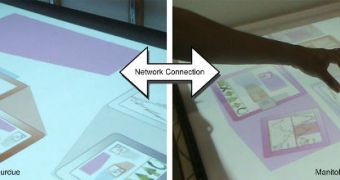Purdue University scientists announced the development of a new software, which allows touch screens and large visual displays to interact with each other in real-time, over a network connection.
The innovation could be used to facilitate business and homeland security applications, the researchers say, but it conceivable that the program could also be used by the entertainment and game industry.
Experts in various fields have lately begun to take an interest in tabletop touch-operated displays, which facilitate their work by allowing total control and intuitive, gesture-based operations.
“These displays are like large iPhones, and because they are large they invite collaboration,” explains Purdue assistant professor of electrical and computer engineering, Niklas Elmqvist.
“So we created a software framework that allows more than one display to connect and share the same space over the Internet,” he goes on to say, adding that the new software is called Hugin.
The system allows for finger-touch commands, which can be used to pan or zoom whatever media the users are operating on the display surface, the researcher explains.
“Hugin was designed for touch screens but can be used with any visual display and input device, such as a mouse and keyboard,” Elmqvist says. The Purdue team constructed a 58-by-37 inches tabletop display device for research purposes.
Twelve test participants were then separated in groups of four. Two were located in West Lafayette, Indiana, on the Purdue Campus, and one in Canada, at the University of Manitoba. The 12 were then asked to cooperate in solving a problem.
The groups reported no problems getting the job done, and praised the system for allowing real-time communications, in spite of the physical distances between the participants.
Details of how the software functions were presented in early November, at the ACM International Conference on Interactive Tabletops and Surfaces 2010, which was held in Saarbrücken, Germany.
Potential users for the new system include defense experts, stock market analysts and emergency crews responding to various disasters. But the Purdue team says that numerous other applications are possible.
“This system could be run in a command center where you have people who have access to a tabletop,” Elmqvist says. He conducted the work with PhF student Waqas Javed and graduate student KyungTae Kim.
“In future iterations it might allow integration of mobile devices connected to the tabletop so emergency responders can see on their small device whatever the people in the command center want them to see,” the expert adds.
“Everyone only sees the things you send to a public domain on the display. This is partly for privacy but also because you don't want to overload everybody with everything you are working on,” Elmqvist concludes.

 14 DAY TRIAL //
14 DAY TRIAL //